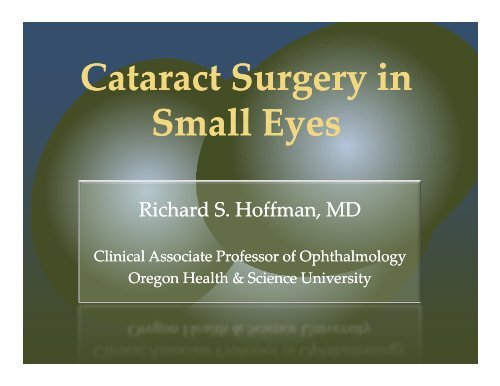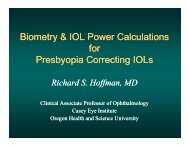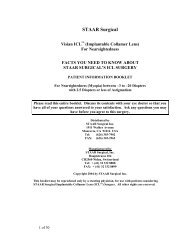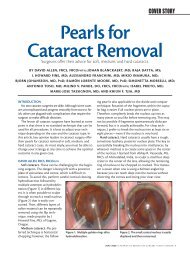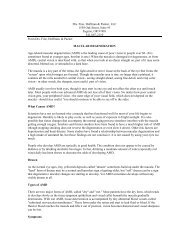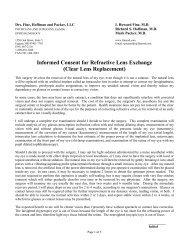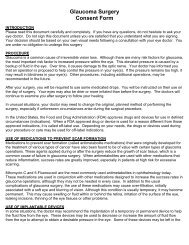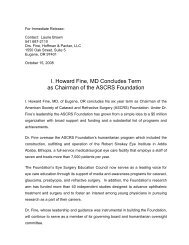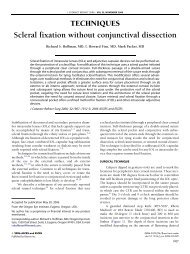Cataract Surgery in Small Eyes
Cataract Surgery in Small Eyes
Cataract Surgery in Small Eyes
You also want an ePaper? Increase the reach of your titles
YUMPU automatically turns print PDFs into web optimized ePapers that Google loves.
<strong>Cataract</strong> <strong>Surgery</strong> <strong>in</strong><br />
<strong>Small</strong> <strong>Eyes</strong><br />
Richard S. Hoffman, MD<br />
Cl<strong>in</strong>ical Associate Professor of Ophthalmology<br />
Oregon Health & Science University
No F<strong>in</strong>ancial Interests
Anatomic Classification<br />
Short AC depth with short axial length<br />
• Nanophthalmos (simple microphthalmos)<br />
microphthalmos<br />
• Colobomatous microphthalmos<br />
• Complex microphthalmos<br />
Short AC depth with normal axial length<br />
• Relative anterior microphthalmos<br />
Normal AC depth with short axial length<br />
• Axial hyperopia
Nanophthalmos<br />
Axial length less than 20.5 mm
(A) Short axial length<br />
(B) <strong>Small</strong> cornea<br />
(C) Shallow AC<br />
Nanophthalmos<br />
Marked iris iris convexity<br />
(D) Normal /Increased lens<br />
thickness<br />
(E) Uveal effusions<br />
(F) Thickened sclera<br />
Thickened choroid
Anatomic Classification<br />
Short AC depth with short axial length<br />
• Nanophthalmos (simple microphthalmos)<br />
microphthalmos<br />
• Colobomatous microphthalmos<br />
• Complex microphthalmos<br />
Short AC depth with normal axial length<br />
• Relative anterior microphthalmos<br />
Normal AC depth with short axial length<br />
• Axial hyperopia
Short AC<br />
AC Depth / Normal Axial Length<br />
Relative Anterior Microphthalmos<br />
More common than nanophthalmos<br />
High <strong>in</strong>cidence of NAG (like<br />
(like nanophthalmos<br />
nanophthalmos)<br />
nanophthalmos<br />
nanophthalmos)<br />
High <strong>in</strong>cidence of corneal guttata and<br />
pseudoexfoliation<br />
No scleral abnormalities<br />
No uveal effusions
Anatomic Classification<br />
Short AC depth with short axial length<br />
• Nanophthalmos (simple microphthalmos)<br />
microphthalmos<br />
• Colobomatous microphthalmos<br />
• Complex microphthalmos<br />
Short AC depth with normal axial length<br />
• Relative anterior microphthalmos<br />
Normal AC depth with short axial length<br />
• Axial hyperopia
Normal AC / Short Axial Length<br />
83% of hyperopes*<br />
hyperopes<br />
No complications<br />
Axial Hyperopia<br />
High refractive errors<br />
IOL calculations<br />
* Holladay JR. AAO 1996.
Preoperative Assessment
Important to identify nanophthalmos<br />
preoperatively due to the potential<br />
hazards of cataract surgery
Nanophthalmos<br />
Topical medications<br />
Laser iridotomy<br />
Laser gonioplasty<br />
Control Glaucoma
Nanophthalmos<br />
Treat before or with<br />
cataract surgery<br />
Uveal Effusion<br />
2 <strong>in</strong>ferior sclerectomies<br />
Triangular full full-thickness thickness
IOL Assessment
Axial Length Determ<strong>in</strong>ation<br />
Critical <strong>in</strong> short eyes<br />
M<strong>in</strong>or error can lead to large<br />
refractive error<br />
Immersion biometry<br />
Optical biometry<br />
Partial coherence<br />
<strong>in</strong>terferometry
Lens Power Calculation<br />
Hoffer Q<br />
Holladay II
Shallow hallow AC depth<br />
Lens powers of 30 D<br />
Normal AC depth<br />
IOL Choice<br />
Hyperopic <strong>Eyes</strong><br />
Lens powers of 40 – 50 D<br />
Polyspeudophakia (Piggyback)
IOL Choice<br />
Piggyback IOLs may be better than<br />
large powered s<strong>in</strong>gle IOL<br />
Less spherical aberration
Piggyback IOLs<br />
First report of piggyback use by<br />
Gayton <strong>in</strong> a case of microphthalmos<br />
Gayton JL, Sanders V. J <strong>Cataract</strong> Refract Surg 1993;19:776-7
Historical Overview<br />
Complications<br />
Both implants placed <strong>in</strong> the capsular bag<br />
• Intractable <strong>in</strong>terlenticular membranes<br />
• Reduced visual acuity<br />
• Late hyperopic shift<br />
Current recommendations<br />
• 1 IOL <strong>in</strong> bag / 1 IOL <strong>in</strong> sulcus<br />
• Simplifies possible IOL exchange
Piggyback IOL Calculations
Piggyback IOL Calculations<br />
Easily calculated utiliz<strong>in</strong>g<br />
the Holladay IOL Consultant<br />
(R Formula)
Piggyback IOL Calculations<br />
No Holladay IOL Consultant
Piggyback IOL<br />
Gills Nomogram<br />
Underpowered Pseudophake (Hyperope Hyperope)<br />
1. Short Eye (27mm): Power = (1.3 x SE) + 1<br />
Overpowered Pseudophake (Myope Myope)<br />
1. Short Eye (27mm): Power = (1.3 x SE) - 1
Piggyback IOL<br />
Nicham<strong>in</strong> Nomogram<br />
Sulcus IOL : AQ2010V<br />
Plus power = 1:1.5 (+5 D SE = +7.5 D IOL)
Piggyback IOL<br />
Brown’s Refractive Reason<strong>in</strong>g<br />
0.50 D IOL power = 0.37 D at spectacle plane
Piggyback IOL Choices
Acrylic<br />
6.0 mm optic<br />
AMO Sensar<br />
13.0 mm overall length<br />
OptiEdge (rounded front)<br />
↓ Pigment dispersion<br />
-10.0 10.0 to +30.0 (half (half-diopter diopter steps)
Silicone<br />
Staar AQ 2010<br />
Th<strong>in</strong> Optic Edges<br />
6.3 mm optic ( larger optic =<br />
AQ2010<br />
• 13.5 mm length<br />
• +5 to +9 D (whole D steps)<br />
• +9.5 to 30 D (half D steps steps)<br />
( larger optic = ↓ iris capture )
Raynor Sulcoflex<br />
Designed for sulcus<br />
placement<br />
Hydrophilic acrylic<br />
Aberration Aberration-neutral<br />
Aberration Aberration-neutral neutral<br />
6.5 mm aspheric aspheric optic<br />
Posterior concave<br />
surface avoids physical contact between IOLs<br />
Undulat<strong>in</strong>g haptics with posterior 10° 10<br />
angulation<br />
• Reduced risk of Pigment Dispersion Syndrome<br />
• Rotational stability
Raynor Sulcoflex<br />
Sulcoflex ® Toric<br />
Sulcoflex ® Multifocal
Surgical Technique
Anesthesia<br />
Topical and <strong>in</strong>tracameral<br />
Local blocks may<br />
<strong>in</strong>crease posterior<br />
pressure and vortex ve<strong>in</strong><br />
congestion
Technique<br />
20% Mannitol (2 ml/kg) for IOP >25 mmHg<br />
Temporal clear corneal <strong>in</strong>cisions<br />
Bimanual <strong>in</strong>cisions best <strong>in</strong> small corneas<br />
Avoid hypotony<br />
Dispersive OVD<br />
Micro<strong>in</strong>cision capsulorhexis
Technique<br />
Limited pars plana vitrectomy may be needed
Technique
Technique<br />
Be aware of short or non non-existent existent pars plana<br />
<strong>in</strong> true nanophthalmos
Technique<br />
Risk of PC rupture <strong>in</strong>creased<br />
• Posterior pressure<br />
• Weakened zonules<br />
• Floppy capsules<br />
• Th<strong>in</strong> capsules<br />
Abort or delay surgery for sudden udden uveal<br />
effusion or hemorrhage<br />
Suture wound to prevent hypotony
F<strong>in</strong>al Comments
<strong>Cataract</strong> <strong>in</strong> the <strong>Small</strong> Eye<br />
Most cases will be rout<strong>in</strong>e<br />
Dist<strong>in</strong>guish nanophthalmos from relative<br />
anterior microphthalmos and axial<br />
hyperopia<br />
Hoffer Q or Holladay II<br />
Piggyback IOLs for > 34 D<br />
Ma<strong>in</strong>ta<strong>in</strong> adequate <strong>in</strong>traoperative IOP<br />
Consider PPV for extremely shallow AC
Obrigado


